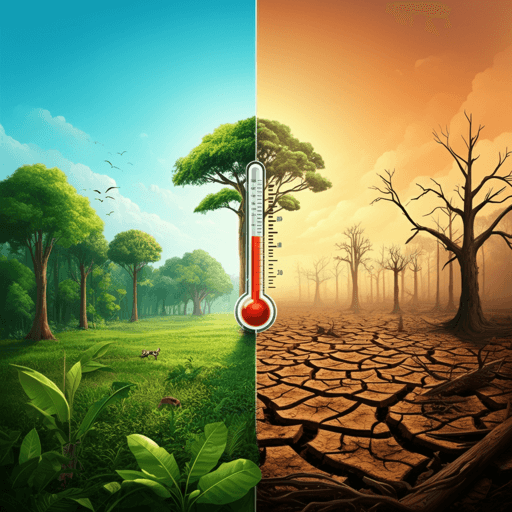
Environmental Studies and Forestry
How climate change and deforestation interact in the transformation of the Amazon rainforest
M. A. Franco, L. V. Rizzo, et al.
Quantifying how deforestation and global climate change reshape the Amazon, this study analyzes long-term atmospheric and land-cover data (1985–2020) across 29 Brazilian Legal Amazon areas, finding global emissions drive >99% of CH4 and CO2 rises while deforestation has sharply raised dry-season temperatures and reduced precipitation (about 74% of a −21 mm dry-season decline and 16.5% of a 2°C max temperature rise). Research conducted by the authors listed in the <Authors> tag.
~3 min • Beginner • English
Introduction
The study addresses how global climate change and deforestation jointly and separately influence key components of the Amazon’s climate system, focusing on dry-season temperature, precipitation, and greenhouse gas (GHG) mixing ratios. The Amazon, a globally critical biome for hydrological, energy, and carbon cycles, has shown trends of warming (~0.15 °C per decade since 1950) and lengthening dry seasons, with highly deforested areas experiencing substantially longer dry periods. Prior research documents shifts from carbon sink to source behavior, drought-driven changes, and complex hydrological responses to land use and climate variability. Despite numerous regional studies, the relative and interacting roles of deforestation and global climate change across the Brazilian Legal Amazon (BLA) remained insufficiently disentangled. This work quantifies and separates these contributions using long-term observational, reanalysis, and satellite data, providing clarity on their interactions and the nonlinear sensitivity of Amazonian climate to forest loss.
Literature Review
Background studies show: (a) the Amazon’s central role in continental-scale climate and carbon storage and its potential shift from sink to source under droughts; (b) observed warming and extended dry seasons linked to climate change; (c) documented impacts of deforestation and forest degradation on precipitation, cloud regimes, and temperature, with stronger effects during the dry season; (d) hydrological studies revealing opposing influences of climate variability and deforestation on streamflow in key basins; (e) satellite-based findings of large precipitation reductions associated with tropical deforestation and increasing methane emissions in eastern Amazonia; and (f) analyses highlighting teleconnections modulating carbon assimilation and evapotranspiration. Collectively, literature underscores the need to separate global GHG-driven trends from regionally driven land-use impacts and to account for nonlinear and seasonal dependencies, particularly during the dry season.
Methodology
Study domain: 29 fixed areas (~300 × 300 km² each) across the Brazilian Legal Amazon (BLA), selected to maximize spatial coverage while excluding regions dominated by water bodies or permanent wetlands. Sensitivity analyses with alternative grid sizes (50 × 50, 100 × 100, 200 × 200 km²) confirmed consistent long-term trends, with some increased variability in dry-season precipitation at smaller scales.
Deforestation definition and quantification: Deforestation is defined via MapBiomas (Collection 6.0) as loss of native forest vegetation to any other land cover class. Deforestation fractions were calculated annually for each area relative to initial 1985 forest cover.
Datasets and platforms: Land use/deforestation (MapBiomas, 30 m, 1985–2020, GEE); Tmax at 2 m (ERA5 Daily Aggregates, 0.25°, 1985–2020, GEE); Dry-season rainfall (GPM IMERG Monthly V06, ~0.1°, 2000–2020, GEE; converted to mm/month); CH4 (AIRS L3 Daily V7, 1°, 400 hPa, 2002–2020, NASA Giovanni); CO2 (Gridded OCO-2 GEOS L3, 0.5° × 0.625°, 2015–2020, NASA Giovanni).
Season definition and processing: Wet/dry seasons were determined per area using percentile thresholds (wet: 75th; dry: 25th of monthly rainfall) from the long-term precipitation climatology, enabling objective, region-specific seasonal assignments. Time series were aggregated to monthly and then annual means per season.
Parametric modeling: Observed relationships showed linear dependence on time (t) and logarithmic dependence on deforestation fraction (D). Initial model y = A ln D + B t + C was extended to capture interaction via A = a1 t + a2 and B = b1 ln D + b2, yielding y(t,D) = (γ t + a2) ln D + b2 t + C (Eq. 4), fitted via least squares. Fit quality was assessed with correlation coefficients and p-values.
Contribution separation: Global (time-driven) and regional (deforestation-driven) contributions were isolated by differentiating Eq. (4): ∂y/∂t|D = γ ln D + b2 and ∂y/∂ ln D|t = γ t + a2, then integrating over the analysis period to obtain y_global and y_regional (Eqs. 7 and 8). This framework harmonized datasets with differing coverage by extrapolating all variables to 1985–2020 for consistent comparison. Analyses emphasized the dry season where deforestation signals are strongest and statistically robust.
Key Findings
- Distinct temporal and land-cover dependencies: Across variables, time dependence is approximately linear (global climate change), whereas deforestation dependence is logarithmic. Dry-season impacts are stronger and more statistically significant than wet-season impacts.
- Parametric fits (dry season) were robust: CH4 R=0.97; CO2 R=0.99; Tmax R=0.74; Rainfall R=0.69; all p<0.05 (Table 2).
- Amazon-wide mean changes (1985–2020): CO2 +86.6–87 ppm; CH4 +172.8–173 ppb; Tmax +~2.0 °C; dry-season rainfall −~21 mm per dry season.
- Separated contributions (median, Fig. 3):
• CO2: Global ~99.75% (Δ≈86.57 ppm); Deforestation ~0.25% (Δ≈0.26 ppm).
• CH4: Global ~99.88% (Δ≈172.56 ppb); Deforestation ~0.12% (Δ≈0.25 ppb).
• Tmax: Global ~83.5% (Δ≈1.63 °C); Deforestation ~16.5% (Δ≈0.39 °C). In the most deforested area (28.5% loss), Tmax increase can reach ~1.25 °C.
• Dry-season rainfall: Deforestation ~74.5% (Δ≈−15.79 mm per dry season); Global ~25.5% (Δ≈−5.16 mm per dry season). In the most deforested area, rainfall reduction can reach ~50.5 mm per dry season.
- Seasonal focus: Dry-season correlations between deforestation and Tmax/precipitation are stronger and more meaningful; wet-season relationships are weaker and often insignificant.
- Pattern differentiation: GHG mixing ratios show smooth, predominantly global-driven increases; Tmax exhibits dual sensitivity to global warming and deforestation; rainfall is strongly modulated by deforestation with weaker long-term global trends.
- Scenario to 2035 (maintaining 2016–2020 deforestation rates, reaching ~32.4% deforested fraction): CO2 +36.7 ppm; CH4 +78 ppb; Tmax +0.62 °C; dry-season rainfall −7.3 mm. Relative to 1985, this implies ~+2.64 °C Tmax and ~−28.3 mm dry-season rainfall, with GHG increases reported as +123.3 ppb (CO2) and +250.8 ppb (CH4).
Discussion
The study disentangles and quantifies the respective roles of global climate change and deforestation in shaping Amazonian dry-season climate. Results demonstrate that GHG mixing ratios are overwhelmingly governed by global emissions, while deforestation dominates regional meteorological changes—especially reductions in dry-season rainfall and increases in daily maximum temperature. The linear time and logarithmic deforestation dependencies reveal a nonlinear sensitivity whereby early stages of forest loss (roughly 10–40%) produce disproportionately large local climate impacts. This synergy indicates that ongoing global warming heightens vulnerability to land-use change, and deforestation further amplifies warming and drying via reduced evapotranspiration and altered cloud regimes.
Spatial differentiation aligns with independent observations showing stronger warming and carbon release in heavily deforested eastern and southeastern Amazonia versus more preserved western regions. Projections under continued deforestation rates suggest additional warming and drying, potentially pushing regional climate toward Cerrado-like seasonality or more arid Caatinga-like conditions, with implications for monsoon dynamics and biome resilience. By providing first-order quantitative separation of drivers, the work informs targeted mitigation strategies: reducing deforestation to preserve rainfall and thermal regulation, while globally curbing GHG emissions to limit the background warming trend.
Conclusion
This work provides a first-order quantitative separation of deforestation versus global climate change impacts on Amazonian dry-season climate using parametric models fitted to multi-decadal observational and satellite datasets. Key contributions include: demonstrating linear time and logarithmic deforestation dependencies; isolating contributions to changes in GHG mixing ratios, maximum temperature, and precipitation; and highlighting the disproportionate role of deforestation in dry-season rainfall decline and its significant share of temperature increase.
Future research should: integrate dynamic Earth system models to capture feedbacks, thresholds, and resilience; extend analyses beyond the BLA to the full transboundary Amazon; refine seasonal and regional cloud-convection mechanisms; link atmospheric mixing ratios with flux-based carbon accounting; and assess policy scenarios that combine deforestation control with global emission reductions to maintain Amazonian climate stability.
Limitations
- Domain restriction: Analysis is limited to the Brazilian Legal Amazon (BLA), not the entire Amazon basin, due to data consistency and availability.
- Data coverage heterogeneity: Variables have different temporal spans (e.g., CO2 2015–2020; CH4 2002–2020; rainfall 2000–2020; Tmax 1985–2020). Harmonization relies on parametric extrapolation, introducing uncertainty.
- Statistical modeling constraints: The parametric approach captures first-order trends and nonlinear interactions but cannot fully represent dynamic feedbacks, thresholds, abrupt transitions, or ecological resilience mechanisms.
- Seasonal focus: Emphasis on dry-season signals may underrepresent wet-season processes dominated by large-scale dynamics.
- GHG representation: Mixing ratios (tropospheric/column) vary smoothly and are partly decoupled from net ecosystem exchange, limiting attribution to local sources/sinks.
- Deforestation definition: Broad classification of forest-to-nonforest transitions without specifying subsequent land uses (e.g., agriculture vs. mining) may obscure land-use-specific impacts.
Related Publications
Explore these studies to deepen your understanding of the subject.







